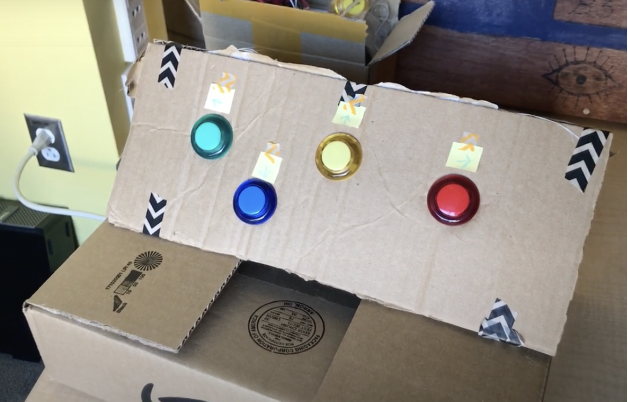Minimal Creation Model: Storytelling Box

A storytelling box can be as simple as a cardboard box that uses buttons to control an audio clip. Here’s how we made one in the Playful City Lab:
Materials We Used:
- Cardboard
- Laptop (or Computer)
- Arcade Buttons
- Makey Makey
Step 1: Wire the buttons to the Makey Makey
Each of the buttons can be wired to a Makey Makey with the help of alligator clips. We have a more detailed explanation of how to get your Makey Makey attached here.
Step 2: Set up the cardboard box
Once you’ve got everything wired, you can set up your box by cutting holes where the buttons will go. You’ll also want an opening for the wire that connects the Makey Makey to a computer. Place the technology pieces inside the box before getting the buttons in and closing the box, as it will be difficult to make changes to the wires after the box is fully constructed.
Step 3: Connect your computer with Google Slides
Plug the Makey Makey into your laptop and place it on or next to the box. Now you can use the buttons to go through a google slide deck you’ve made on your laptop. If you’ve reached this step, congratulations. You’ve just completed a simple storytelling box.
Add-Ons and Substitutions
There are plenty of ways to remix and tailor this original project for your storytelling or physical installation needs. Here are just a few examples of ways that you can alter the original design:
- Swap the Buttons and Laptop for a Touchscreen: Instead of using the arcade buttons as the primary input to control a laptop, you can use a touchscreen. The touchscreen is both the visual element of a monitor and the input that controls the storytelling box. This consolidation of technology can allow more time to be spent on the design and manufacture of the physical box.
- Replace the Cardboard: We advocate for starting with a low-risk, found material like cardboard because it is easy to work with and has wider availability. One way to polish up your project is to upgrade from using cardboard to a more permanent material like wood, acrylic, etc.
- Add External Signage: Either as a part of your storytelling box experience or to gain visibility for your project, use signage to your advantage. You can use this to give instructions to your participants or expand their experience with a static, visual element.
- Get Artistic: Create a physical installation that could be a work of art. Paint it, use sculpting materials to build it out, hook up some LED lights. If you are using a Makey Makey, you can even try to use something conductive that can also act as an input to control the storytelling box.
Some related readings:
